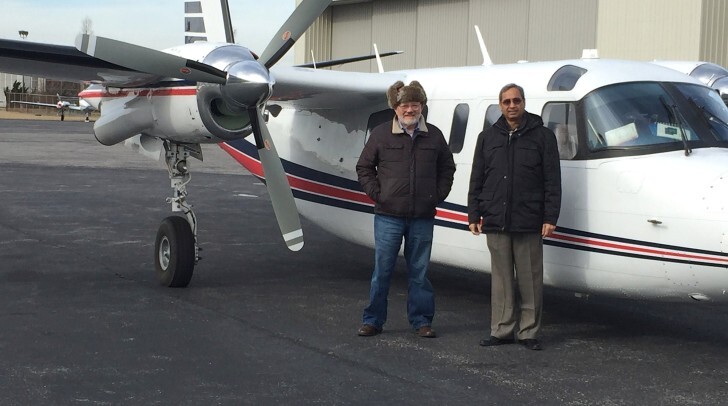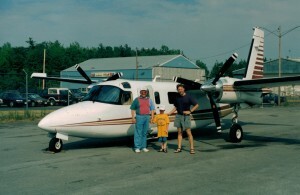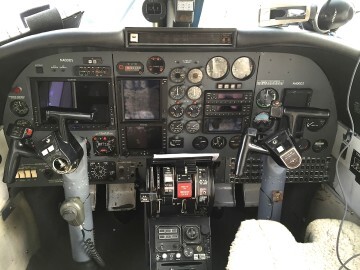
Abe Abuchowski (left) is flying a leased 690B while his 690B gets updated with a Garmin G950 panel. To his right is Dr. Hemant Misra, VP Clinical Operations at Prolong Pharmaceuticals where Abuchowski is CEO.
Picking the right airplane requires that you apply objective, dispassionate science to the search. After all, science is all about facts because facts never lie. But here’s the problem: a just-the-facts approach can result in a bland outcome, an airplane that may check all the mission criteria boxes but falls short in one unrelated but important characteristic –– it’s ability to excite. To achieve complete scientific and emotional satisfaction with your choice of airplane, it helps to stir a little bit of art into the analysis. Abraham “Abe” Abuchowski is that artful scientist.
First, the science. Abe is a biochemist. As a doctoral student at Rutgers University, he wrote a thesis on development of a new technology for protein drug delivery. That technology, subsequently named PEGylation, is now the accepted standard in the field, and earned him the unofficial title of “the father of PEGylation.”
While an Assistant Professor in Rutgers Department of Biochemistry he developed what has become the mainstay drug for the treatment of acute lymphoblastic leukemia in children. His career has centered on the science of drug delivery, and today he is an internationally recognized authority and the author of numerous scientific papers and book chapters on therapeutic products.
Now for the art. Abe left the science-focused academic world in 1983 for more artful, entrepreneurial pursuits, and founded a company to commercially develop PEGylation. The company, Enzon, Inc., grew to become a fully integrated pharmaceutical company with several successful drugs. Abe was recognized as New Jersey’s 1990 entrepreneur of the year for high technology, and later became a consultant to help other entrepreneurs become successful. More recently he launched another pharmaceutical company where he still serves as CEO.
A scientist might say that time can’t be rushed. It takes time to design, develop, and test new drugs. An entrepreneur would say that time is money –– the longer it takes for a drug to get to market, the more money it costs the pharmaceutical company. Abe the artful scientist understands both perspectives, which is why he uses airplanes.
Faster, Smarter, More Efficient
“Part of my success was an absolute desire to move things along as fast as possible,” he says. “I am one of those ‘do it faster, smarter, and more efficient’ guys.
“To get the physicians knowledgeable about our products and get hospitals to use our products I had to travel around, do lectures, and get physicians to do clinical trials and monitor those trials. It was impossible to do by phone –– you gotta look people in the eye. But commercial aviation just didn’t do it for me. The flight schedules wouldn’t make certain trips possible.
“I was already a pilot, but I needed an aircraft. I started with a helicopter but quickly found that it was not fast nor capable enough for my missions.” Next came a Bonanza A36, but it too proved too limiting so Abe moved up to a pressurized Baron 58P. It did a much better job for him, but something happened that changed his direction in aviation: he met Matt Hagans at Eagle Creek Aviation Services.

Abuchowski with son Sam (middle) and friend Kevin Kilcullen in front of his first 690B.
Abe laughs. “My world changed,” he says. “He is quite a dynamic individual. I love the guy. He showed me how a Commander could do a lot more for me than the Baron.”
That was in the early 1990s, when Eagle Creek was developing the Dash 10T engine conversion for Dash 5-powered Commanders. The 40-knot gain in cruise speed appealed to Abe’s go-fast leanings. “I wanted to be the first guy to have them,” he says, “so I bought a Dash 10T-powered Commander 690B from Matt.
“I loved it. It was incredibly capable, a real pilot’s airplane. I was able to fly all around the country, and it helped me and the company become as successful as we were.”
Abe retired from Enzon in 1996, and found he no longer needed a fast, long-range airplane. He sold the Commander and flew rented piston singles to stay current. Eventually he bought into a Cirrus SR22. Retirement ended six years later when he founded Prolong Pharmaceuticals to further apply PEGylation technology in the development of biopharmaceuticals. As the company developed new products and grew from six to 50 employees, Abe found himself in familiar territory –– “I needed to get places quickly, to talk to people and move our products along.” He needed an airplane.

Modern Garmin panel in the leased 690B will be topped by even more modern G950 panel in his 690B.
Problematic Flights
At first he relied on the Cirrus. It was fine for short trips from Abe’s central New Jersey base, but longer flights, such as to Florida to visit a primary supplier, were problematic. “The flight to Florida is not one the Cirrus does easily,” he says. “If I had to stop and refuel it made for a long day. It was too limiting, not all-weather and, boy, that means a lot. If there was a possibility of low-level icing, you are done for the day.”
Abe analyzed the options. A Piper Aerostar or Meridian? Nope. “I’m 66, and I have my aches and pains,” he says. “I need a comfortable cabin to get in and out of.”
How about a light jet? Nice thought, but no-go because of lack of cabin size, range, and short-field capability. How about returning to a Baron 58P? That made the most sense to Abe, except when compared to a twin turboprop. But not just any twin turboprop. “I like the Commander,” he says. “It’s spacious, it carries a lot of weight, it can go a good distance at a decent speed –– 300 knots, and it flies nice.”
Abe decided he needed to get into another 690B. “I convinced the board, and they agreed it’s a rational thing to do.” Abe went back to his friend Matt Hagans and learned that Eagle Creek had just certified the Garmin 950 integrated panel and S-TEC 2100 Digital Flight Control System in the Commander 695 series.
“Matt was interested in putting a G950 panel in my airplane, and I was interested in having it in the airplane,” Abe says. ““I think it will make the airplane more valuable. The new avionics make you more aware of the flight environment. It’s modern, with more information when things start to go wrong. It’s tracking itself to a greater degree. Instead of me diagnosing problems it is telling me when a problem occurs, just like modern medicine.
“The new digital autopilot will fly the airplane better than old analog autopilot,” he adds. “It’s more responsive. I’m really looking forward to them putting the airplane together and flying it.”
His will be the first 690-series Commander to get the Garmin G950 and autopilot upgrade. Meanwhile, he is flying a leased 690B while his airplane is being upgraded.
When we spoke he was preparing for a trip to Richmond, Virginia, then to Ann Arbor, Michigan, the next day, then back to New Jersey. The following week’s schedule called for trips to Charleston, South Carolina, and Indianapolis, then to Florida the week after that. “I make these kinds of trips all the time,” he says. “Last month it was Chicago, and twice to Florida.” He’s averaging about 15 flying hours a month, and he and a copilot –– a company requirement –– often take employees with them on visits to physicians, hospitals, and industry events.
“People ask me, ‘Why do you have an airplane? Airplanes are expensive,’ ” he says. “I ask them, ‘Why do you have a car?’ The airplane is my car. It saves me time, and time is money. I don’t think people understand that.
“While it does cost a lot to operate an airplane, the returns are 10, 20, 30 times greater,” he says. “An airplane doesn’t save you money, it makes you money. You’ve got to be willing to invest in it to make money. Think about it. If you are going to develop even a small drug, the market may be $200 million a year. But the timeframe for drug development is 10-to-12 years. If an airplane can help you get it approved six months faster, that is $100 million in value.”
That is an artful approach to a fact-based analysis of why flying a capable airplane makes all kinds of sense to Abe Abuchowski. “What can I say,” he smiles. “I’m a scientist.”
